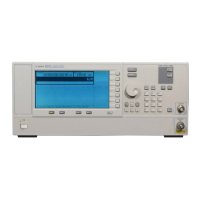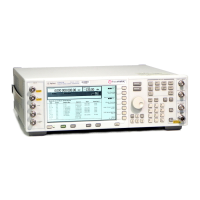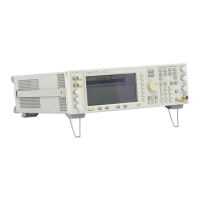Optimizing Performance
Creating and Applying User Flatness Correction
Chapter 3 71
7. Press
# of Points > 28 > Enter.
This enters the desired flatness-corrected frequencies (26.5 GHz to 40 GHz in 500 MHz
intervals) into the step array.
8. Press
Return > Load Cal Array From Step Array > Confirm Load From Step Sweep.
This populates the user flatness correction array with the frequency settings defined in the
step array.
9. Press
Amplitude > 0 > dBm.
10.Press
RF On/Off.
This activates the RF output and the RF ON annunciator is displayed on the signal
generator.
Perform the User Flatness Correction
NOTE If you are not using an Agilent E4416A/17A/18B/19B power meter, or if your
power meter does not have a GPIB interface, you can perform the user flatness
correction manually. For instructions, see “Performing the User Flatness
Correction Manually” below.
1. Press
More (1 of 2) > User Flatness > Do Cal.
This creates the user flatness amplitude correction value table entries. The signal
generator begins the user flatness correction routine and a progress bar is shown on the
display.
2. When prompted, press
Done.
This loads the amplitude correction values into the user flatness correction array.
If desired, press
Configure Cal Array.
This opens the user flatness correction array, where you can view the list of defined
frequencies and their calculated amplitude correction values. The user flatness correction
array title displays User Flatness: (UNSTORED) indicating that the current user flatness
correction array data has not been saved to the memory catalog.

